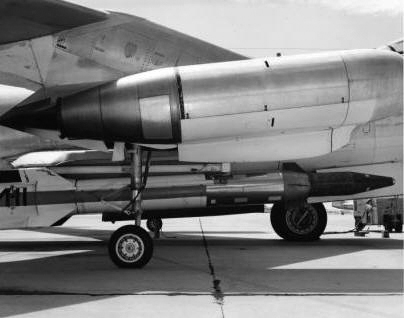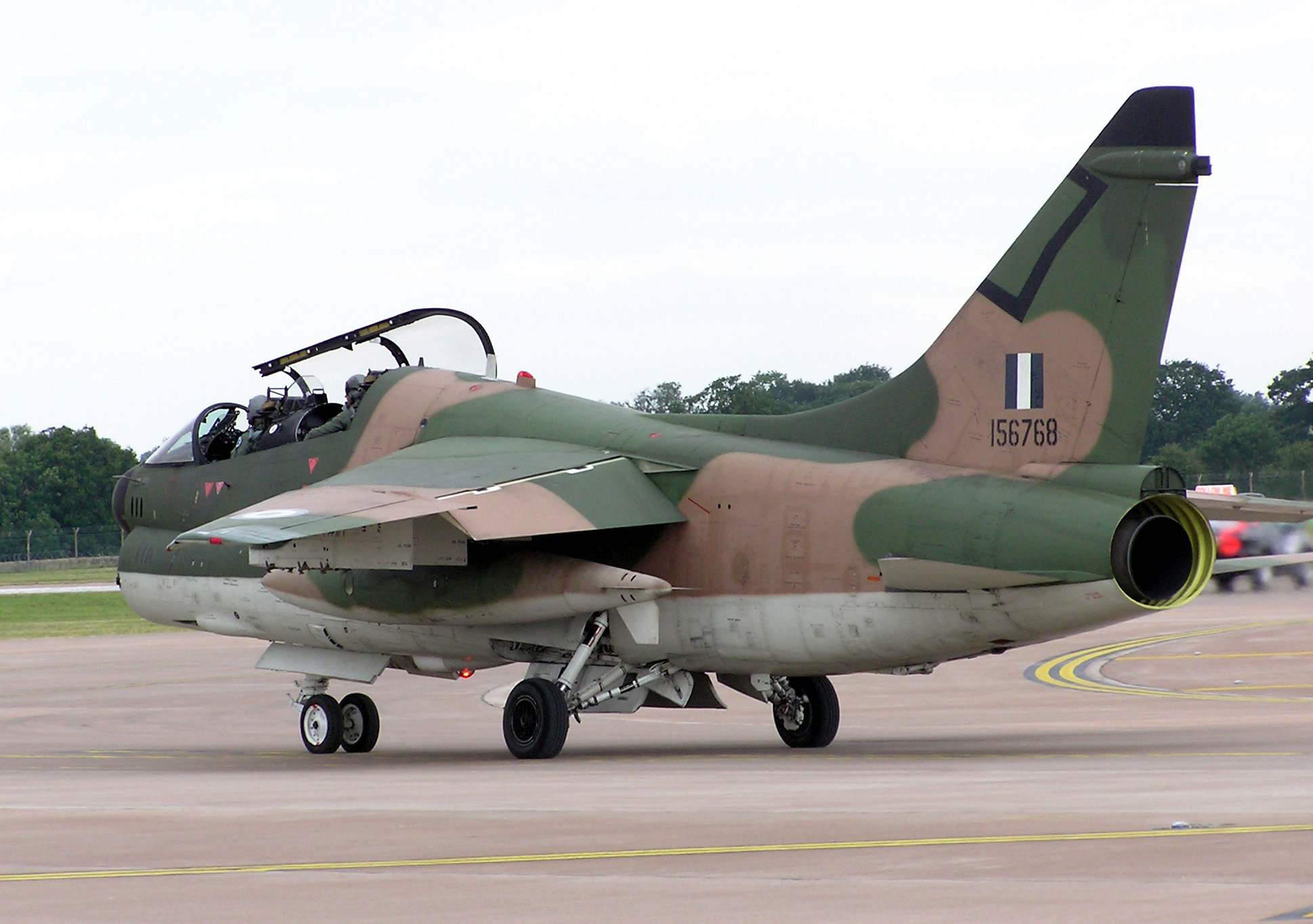|
ASM-135
The ASM-135 ASAT is an air-launched anti-satellite multistage missile that was developed by Ling-Temco-Vought's LTV Aerospace division. The ASM-135 was carried exclusively by United States Air Force (USAF) F-15 Eagle fighter aircraft. Development Starting in the late 1950s, the United States began development of anti-satellite weapons. The first US anti-satellite weapon was the Bold Orion Weapon System 199B (also the High Virgo missile, Weapon System 199C, attempted to conduct an ASAT test but failed to intercept its target; High Virgo's test was a few weeks before Bold Orion's). Like the ASM-135, the Bold Orion missile was air-launched, but in this case from a B-47 Stratojet. The Bold Orion was tested on 13 October 1959 against the Explorer 6 satellite.Edited By Bhupendra Jasani, ''Space Weapons and International Security'', A SIPRI Publication, Oxford University Press, 1987. The two-stage Bold Orion missile passed within of Explorer 6. From this distance, only a relatively ... [...More Info...] [...Related Items...] OR: [Wikipedia] [Google] [Baidu] |
F-15 Eagle
The McDonnell Douglas F-15 Eagle is an American Twinjet, twin-engine, all-weather Air combat manoeuvring#Tactics, tactical fighter aircraft designed by McDonnell Douglas (now part of Boeing). Following reviews of proposals, the United States Air Force selected McDonnell Douglas's design in 1969 to meet the service's need for a dedicated air superiority fighter. The Eagle first flew in July 1972, and entered service in 1976. It is among the most successful modern fighters, with over 100 victories and no losses in aerial combat, with the majority of the kills by the Israeli Air Force.Spick 2000, p. 127. The Eagle has been exported to Israel, Japan, and Saudi Arabia. The F-15 was originally envisioned as a pure air-superiority aircraft. Its design included a secondary ground-attack capability that was largely unused. The aircraft design proved flexible enough that an improved all-weather strike fighter, strike derivative, the McDonnell Douglas F-15E Strike Eagle, F-15E Strike Ea ... [...More Info...] [...Related Items...] OR: [Wikipedia] [Google] [Baidu] |
Anti-satellite Weapon
Anti-satellite weapons (ASAT) are space weapons designed to incapacitate or destroy satellites for strategic or tactical purposes. Several nations possess operational ASAT systems. Although no ASAT system has been utilised in warfare, a few countries (China, India, Russia, United Kingdom and the United States) have successfully shot down their own satellites to demonstrate their ASAT capabilities in a show of force. ASATs have also been used to remove decommissioned satellites. ASAT roles include: defensive measures against an adversary's space-based and nuclear weapons, a force multiplier for a nuclear first strike, a countermeasure against an adversary's anti-ballistic missile defence (ABM), an asymmetric counter to a technologically superior adversary, and a counter-value weapon. Use of ASATs generates space debris, which can collide with other satellites and generate more space debris. A cascading multiplication of space debris could cause Earth to suffer from ... [...More Info...] [...Related Items...] OR: [Wikipedia] [Google] [Baidu] |
Bold Orion
The Bold Orion missile, also known as Weapons System 199B (WS-199B), was a prototype air-launched ballistic missile (ALBM) developed by Martin Aircraft during the 1950s. Developed in both one- and two-stage designs, the missile was moderately successful in testing, and helped pave the way for development of the GAM-87 Skybolt ALBM. In addition, the Bold Orion was used in early anti-satellite weapons testing, performing the first interception of a satellite by a missile. Design and development The Bold Orion missile was developed as part of Weapons System 199, initiated by the United States Air Force (USAF) in response to the U.S. Navy's Polaris program, with funding authorised by the United States Congress in 1957.Yengst 2010, p.37. The purpose of WS-199 was the development of technology that would be used in new strategic weapons for the USAF's Strategic Air Command, not to deliver operational weapons; a primary emphasis was on proving the feasibility of an air-launched ball ... [...More Info...] [...Related Items...] OR: [Wikipedia] [Google] [Baidu] |
Ling-Temco-Vought
Ling-Temco-Vought (LTV) was a large American conglomerate which existed from 1961 to 2000. At its peak, it was involved in aerospace, airlines, electronics, steel manufacturing, sporting goods, meat packing, car rentals, and pharmaceuticals, among other businesses. It began in 1947 as Ling Electric Company, later named Ling-Temco-Vought, followed by LTV Corporation and eventually LTV Steel until its end in 2001. History Ling Electric Company In 1947, entrepreneur James Ling founded an electrical contracting business, Ling Electric Company, in Dallas, Texas. He lived in the rear of the shop. After incorporating and taking the company public in 1955, Ling found innovative ways to market the stock, including selling door-to-door and from a booth at the State Fair of Texas. Ling-Temco-Vought In 1956 Ling bought L.M. Electronics, and in 1959 added Altec Electronics, a maker of stereo systems and speakers. In 1960 Ling merged the company with Temco Aircraft, best known for its m ... [...More Info...] [...Related Items...] OR: [Wikipedia] [Google] [Baidu] |
NOTS-EV-2 Caleb
The NOTS-EV-2 Caleb, also known as NOTS-500, Hi-Hoe and SIP was an expendable launch system, which was later used as a sounding rocket and prototype anti-satellite weapon. It was developed by the United States Navy's United States Naval Ordnance Test Station, Naval Ordnance Test Station (NOTS) as a follow-up to the NOTS-EV-1 Pilot, which had been abandoned following ten launches officially classified as failed missions. Two were launched in July and October 1960, before the cancellation of the project. Following cancellation, two leftover Calebs were used in the Satellite Interceptor Program (SIP), while three more were used as sounding rockets, under the designation Hi-Hoe. These derivatives flew until July 1962, when the Hi-Hoe made its final flight. Development The Caleb was originally designed as a fast-response orbital launch system, to place small reconnaissance satellites, and other military payloads, into orbit at short notice. The orbital configurations were four-stage ve ... [...More Info...] [...Related Items...] OR: [Wikipedia] [Google] [Baidu] |
High Virgo
The High Virgo, also known as Weapons System 199C (WS-199C), was a prototype air-launched ballistic missile (ALBM) jointly developed by Lockheed and the Convair division of General Dynamics during the late 1950s. The missile proved moderately successful and aided in the development of the later GAM-87 Skybolt ALBM. It was also used in early tests of anti-satellite weapons. Design and development As part of the WS-199 project to develop new strategic weapons for the United States Air Force's Strategic Air Command, the Lockheed Corporation and the Convair division of General Dynamics proposed the development of an air-launched ballistic missile, to be carried by the Convair B-58 Hustler supersonic medium bomber.Parsch 2005 In early 1958 the two companies were awarded a contract for development of the weapon, designated WS-199C and given the code-name "High Virgo". While the project was intended to be strictly a research-and-development exercise, it was planned that the weapon wo ... [...More Info...] [...Related Items...] OR: [Wikipedia] [Google] [Baidu] |
Satellite Interceptor Program
The NOTS-EV-2 Caleb, also known as NOTS-500, Hi-Hoe and SIP was an expendable launch system, which was later used as a sounding rocket and prototype anti-satellite weapon. It was developed by the United States Navy's Naval Ordnance Test Station (NOTS) as a follow-up to the NOTS-EV-1 Pilot, which had been abandoned following ten launches officially classified as failed missions. Two were launched in July and October 1960, before the cancellation of the project. Following cancellation, two leftover Calebs were used in the Satellite Interceptor Program (SIP), while three more were used as sounding rockets, under the designation Hi-Hoe. These derivatives flew until July 1962, when the Hi-Hoe made its final flight. Development The Caleb was originally designed as a fast-response orbital launch system, to place small reconnaissance satellites, and other military payloads, into orbit at short notice. The orbital configurations were four-stage vehicles, whilst test launches used one- and ... [...More Info...] [...Related Items...] OR: [Wikipedia] [Google] [Baidu] |
Missile
In military terminology, a missile is a guided airborne ranged weapon capable of self-propelled flight usually by a jet engine or rocket motor. Missiles are thus also called guided missiles or guided rockets (when a previously unguided rocket is made guided). Missiles have five system components: targeting, guidance system, flight system, engine and warhead. Missiles come in types adapted for different purposes: surface-to-surface and air-to-surface missiles ( ballistic, cruise, anti-ship, anti-submarine, anti-tank, etc.), surface-to-air missiles (and anti-ballistic), air-to-air missiles, and anti-satellite weapons. Airborne explosive devices without propulsion are referred to as shells if fired by an artillery piece and bombs if dropped by an aircraft. Unguided jet- or rocket-propelled weapons are usually described as rocket artillery. Historically, the word ''missile'' referred to any projectile that is thrown, shot or propelled towards a target; this usag ... [...More Info...] [...Related Items...] OR: [Wikipedia] [Google] [Baidu] |
United States Air Force
The United States Air Force (USAF) is the air service branch of the United States Armed Forces, and is one of the eight uniformed services of the United States. Originally created on 1 August 1907, as a part of the United States Army Signal Corps, the USAF was established as a separate branch of the United States Armed Forces in 1947 with the enactment of the National Security Act of 1947. It is the second youngest branch of the United States Armed Forces and the fourth in order of precedence. The United States Air Force articulates its core missions as air supremacy, global integrated intelligence, surveillance and reconnaissance, rapid global mobility, global strike, and command and control. The United States Air Force is a military service branch organized within the Department of the Air Force, one of the three military departments of the Department of Defense. The Air Force through the Department of the Air Force is headed by the civilian Secretary of the Ai ... [...More Info...] [...Related Items...] OR: [Wikipedia] [Google] [Baidu] |
Program 437
Program 437 was the second anti-satellite weapons program of the U.S. military.Peebles, Curtis. "High Frontier: The United States Air Force and the Military Space Program", 1997 The US anti-satellite weapons program began development in the early 1960s and was officially discontinued on 1 April 1975. Program 437 was approved for development by U.S. Secretary of Defense Robert McNamara on November 20, 1962, after a series of tests involving high altitude nuclear explosions. The program's facilities were located on Johnston Island, an isolated island in the north central Pacific Ocean. History The US's first anti-satellite system was Program 505, based at the Kwajalein Missile Range, about halfway between Hawaii and the Philippine islands. This system became operational in 1962, based on the Nike Zeus anti-ballistic missile that had been tested at that site. These missiles had been modified for greater range, but even with these modifications the system could only intercept ... [...More Info...] [...Related Items...] OR: [Wikipedia] [Google] [Baidu] |
20180328 ASM-135 ASAT Udvar-Hazy
Eighteen or 18 may refer to: * 18 (number), the natural number following 17 and preceding 19 * one of the years 18 BC, AD 18, 1918, 2018 Film, television and entertainment * ''18'' (film), a 1993 Taiwanese experimental film based on the short story ''God's Dice'' * ''Eighteen'' (film), a 2005 Canadian dramatic feature film * 18 (British Board of Film Classification), a film rating in the United Kingdom, also used in Ireland by the Irish Film Classification Office * 18 (''Dragon Ball''), a character in the ''Dragon Ball'' franchise * "Eighteen", a 2006 episode of the animated television series ''12 oz. Mouse'' Music Albums * ''18'' (Moby album), 2002 * ''18'' (Nana Kitade album), 2005 * '' 18...'', 2009 debut album by G.E.M. Songs * "18" (5 Seconds of Summer song), from their 2014 eponymous debut album * "18" (One Direction song), from their 2014 studio album ''Four'' * "18", by Anarbor from their 2013 studio album ''Burnout'' * "I'm Eighteen", by Alice Cooper commonly r ... [...More Info...] [...Related Items...] OR: [Wikipedia] [Google] [Baidu] |
Warhead
A warhead is the forward section of a device that contains the explosive agent or toxic (biological, chemical, or nuclear) material that is delivered by a missile, rocket, torpedo, or bomb. Classification Types of warheads include: * Explosive: An explosive charge is used to disintegrate the target, and damage surrounding areas with a blast wave. ** Conventional: Chemicals such as gunpowder and high explosives store significant energy within their molecular bonds. This energy can be released quickly by a trigger, such as an electric spark. Thermobaric weapons enhance the blast effect by utilizing the surrounding atmosphere in their explosive reactions. *** Blast: A strong shock wave is provided by the detonation of the explosive. *** Fragmentation: Metal fragments are projected at high velocity to cause damage or injury. *** Continuous rod: Metal bars welded on their ends form a compact cylinder of interconnected rods, which is violently expanded into a contiguous zig- ... [...More Info...] [...Related Items...] OR: [Wikipedia] [Google] [Baidu] |









.jpg)